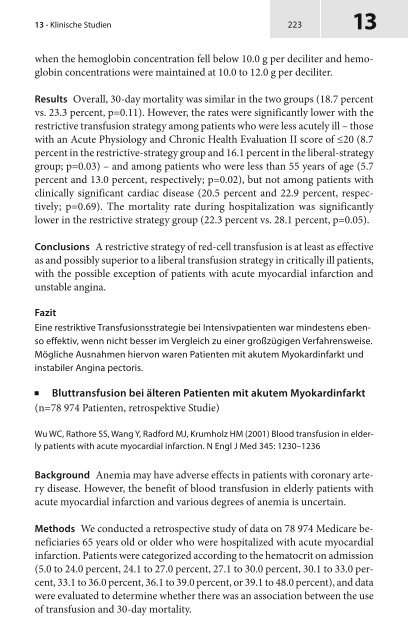Intensivmedizin Fragen und Antworten
Sie wollen auch ein ePaper? Erhöhen Sie die Reichweite Ihrer Titel.
YUMPU macht aus Druck-PDFs automatisch weboptimierte ePaper, die Google liebt.
13 · Klinische Studien<br />
223<br />
13<br />
when the hemoglobin concentration fell below 10.0 g per deciliter and hemoglobin<br />
concentrations were maintained at 10.0 to 12.0 g per deciliter.<br />
Results Overall, 30-day mortality was similar in the two groups (18.7 percent<br />
vs. 23.3 percent, p=0.11). However, the rates were significantly lower with the<br />
restrictive transfusion strategy among patients who were less acutely ill – those<br />
with an Acute Physiology and Chronic Health Evaluation II score of ≤20 (8.7<br />
percent in the restrictive-strategy group and 16.1 percent in the liberal-strategy<br />
group; p=0.03) – and among patients who were less than 55 years of age (5.7<br />
percent and 13.0 percent, respectively; p=0.02), but not among patients with<br />
clinically significant cardiac disease (20.5 percent and 22.9 percent, respectively;<br />
p=0.69). The mortality rate during hospitalization was significantly<br />
lower in the restrictive strategy group (22.3 percent vs. 28.1 percent, p=0.05).<br />
Conclusions A restrictive strategy of red-cell transfusion is at least as effective<br />
as and possibly superior to a liberal transfusion strategy in critically ill patients,<br />
with the possible exception of patients with acute myocardial infarction and<br />
unstable angina.<br />
Fazit<br />
Eine restriktive Transfusionsstrategie bei Intensivpatienten war mindestens ebenso<br />
effektiv, wenn nicht besser im Vergleich zu einer großzügigen Verfahrensweise.<br />
Mögliche Ausnahmen hiervon waren Patienten mit akutem Myokardinfarkt <strong>und</strong><br />
instabiler Angina pectoris.<br />
jBluttransfusion bei älteren Patienten mit akutem Myokardinfarkt<br />
(n=78 974 Patienten, retrospektive Studie)<br />
Wu WC, Rathore SS, Wang Y, Radford MJ, Krumholz HM (2001) Blood transfusion in elderly<br />
patients with acute myocardial infarction. N Engl J Med 345: 1230–1236<br />
Backgro<strong>und</strong> Anemia may have adverse effects in patients with coronary artery<br />
disease. However, the benefit of blood transfusion in elderly patients with<br />
acute myocardial infarction and various degrees of anemia is uncertain.<br />
Methods We conducted a retrospective study of data on 78 974 Medicare beneficiaries<br />
65 years old or older who were hospitalized with acute myocardial<br />
infarction. Patients were categorized according to the hematocrit on admission<br />
(5.0 to 24.0 percent, 24.1 to 27.0 percent, 27.1 to 30.0 percent, 30.1 to 33.0 percent,<br />
33.1 to 36.0 percent, 36.1 to 39.0 percent, or 39.1 to 48.0 percent), and data<br />
were evaluated to determine whether there was an association between the use<br />
of transfusion and 30-day mortality.


